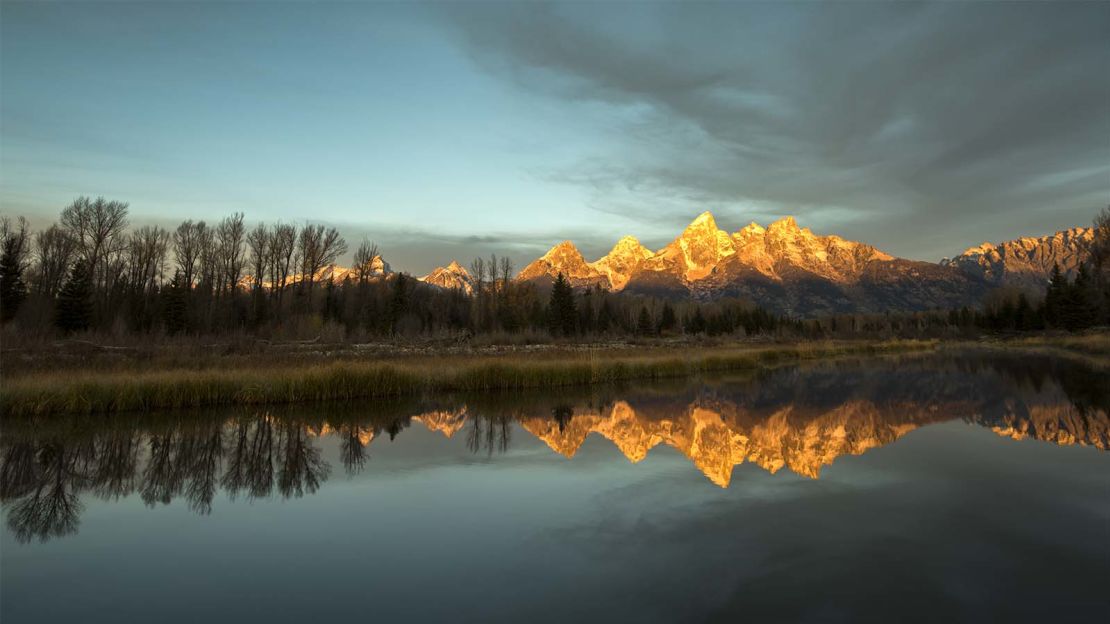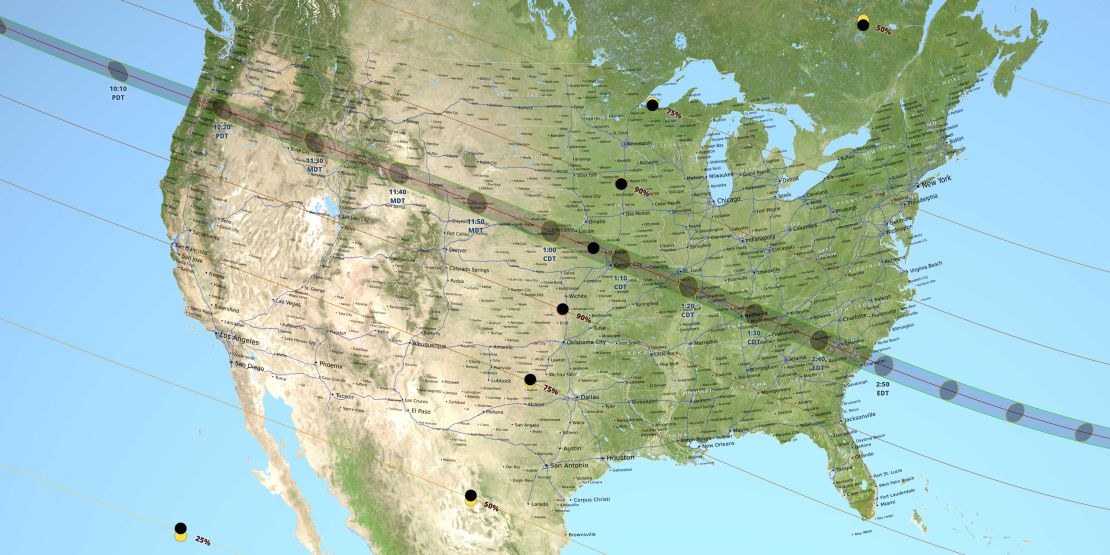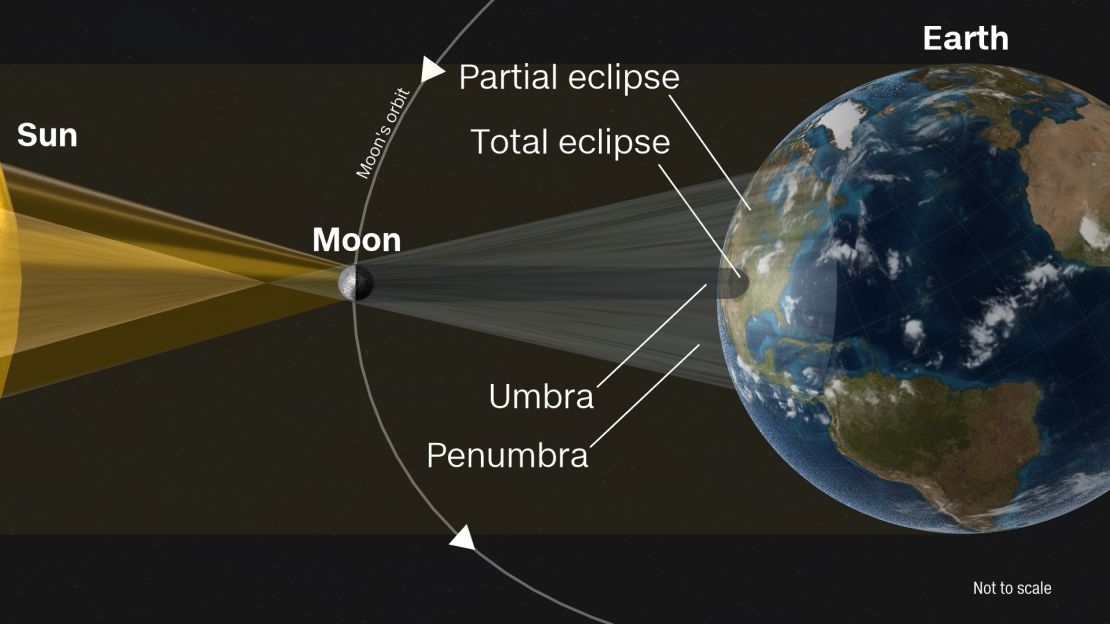Editor’s Note: For complete coverage of the Eclipse of the Century go to cnn.com/eclipse. Watch live, in virtual reality, as the eclipse moves coast to coast on August 21.
We’ve all heard about those lovers of astronomy, those fans of nature and science, all of whom have been planning for years to travel to see this year’s total solar eclipse.
This is not about those people.
Hello to those non-planners who have been more focused on summer vacation, back to school specials and the latest episodes of “Game of Thrones”!
You may have just realized that the sun will be completely blocked by the moon for a brief period on Monday, August 21, in parts of the United States.
The nation’s first total solar eclipse since 1979 and the first to cross from the West Coast to the East Coast since 1918, the 2017 eclipse will cross from Oregon to South Carolina and “the path of totality” along the way will be up to 70 wiles wide.
What’s the weather forecast for August 21?
It’s a financial bonanza for hotels, restaurants, bars, campgrounds and festivals along the route, with many selling out their rooms and events months in advance. Those that remain are selling at a premium mark-up.
“A total eclipse is such a rare occurrence, for many in the US this will be the first time in their life they can see one,” says CNN Senior Meteorologist Brandon Miller. “The path of this eclipse makes it a once-in-a lifetime event in that it transects the country almost down the middle - meaning it is a one-day drive for a vast majority of the nation.”
We have good news! It’s not too late for a slacker to see the eclipse, provided you can stand up getting up early to drive to see it. For those of you who have put off planning a weekend dedicated to the moon and the sun, CNN offers a slacker’s guide to the total eclipse of 2017.
(Just don’t be a slacker with your supplies. NASA and the National Park Service advises travelers to stock up on water, snacks, sunscreen – and your solar eclipse viewing glasses – before leaving home.)
Homestead National Monument, Nebraska

Bill Nye the Science Guy will join NASA scientists Dr. Amy Mainzer, Dr. Kelsey Young, Dr. Edwin Grayzeck and more for a full day of free events at Homestead on August 21. Park rangers will also shine the light on a new Eclipse Explorer Junior Ranger program.
Use Gage County’s free shuttle service to get around, since parking will be severely restricted in the area.
Can’t get to Homestead? The eclipse will cross over 21 national park sites and 7 trails. See whether one is near you.
John Day Fossil Beds National Monument, Oregon
Eastern Oregon is a prime viewing spot for the eclipse, and John Day Fossil Beds National Monument is preparing for big crowds starting nearly a week before the August 21 show.
The eclipse will be visible at all three park units, which is home to ecosystems dating back 40 million years.
Ketchum and Sun Valley, Idaho

Ketchum and Sun Valley are hosting a joint solar eclipse viewing party on Festival Field on Sun Valley Road, in addition to artist studio tours, “lit” walks sponsored by the local library and other events throughout the week.
Just an hour’s drive west, Sawtooth National Forest’s reserved and unreserved campsites are expected to be filled up by the August 19 weekend. But the national forest will be still be welcoming day trippers – just arrive early before all the parking spots are filled.
Carbondale, Illinois
Southern Illinois University Carbondale is hosting a massive ticketed event at Saluki Stadium, with NASA Eclipse 2017, the Adler Planetarium of Chicago and the Louisiana Space Consortium all participating in the festivities there. But the eclipse will be viewable outside the stadium and throughout the city of Carbondale, where there will be a marketplace and music festival.
The nearby Crab Orchard National Wildlife Refuge isn’t planning any formal events but the eclipse will be viewable from publicly accessible parts of the refuge.
Grand Teton National Park, Wyoming

Astronomers and park rangers will host events at Grand Teton National Park, which has designated five eclipse viewing areas within the national park.
While a lot of parking is first-come, first-served, some passes will start becoming available on August 19, two days before the eclipse.
The Remington Nature Center, St. Joseph, Missouri
St. Joe has a lot planned for the eclipse. Next to the Missouri River, the Remington Nature Center will have extended hours on August 21, and admission is just $3 for adults, $2 for senior and $1 for children 4-15 and free for those 3 and younger.
The public can also watch the eclipse in the nature center parking lot and on the property of the nearby St Joe Frontier Casino, at Riverfront Park and along the Riverwalk.
Night at Noon, Paducah, Kentucky

Former astronaut and Kentucky native Terry Wilcutt, who serves as NASA’s chief of safety and mission assurance, will headline the “Night at Noon” eclipse party hosted by West Kentucky Community and Technical College on the lawn of the Challenger Learning Center.
There will also be a NASA High Altitude Balloon Launch, organizers say, one of dozens across the country.
Clarksville, Tennessee
The city of Clarksville will host several free and low-fee events across town, including Fortera Stadium at Austin Peay State University, Clarksville Regional Airport and Liberty Park.
Austin Peay’s Department of Physics and Astronomy has been training students as “Eclipse Educators” to teach people more about the eclipse at viewing spots throughout the city.
Tallulah Gorge State Park, Georgia

A two-hour drive north of Atlanta, Tallulah Gorge State Park is hosting an afternoon eclipse viewing party from 1 p.m. to 3 p.m. – one of 12 state parks to mark the day. The park opens at 8 a.m., and the parking lot could get full quickly. The Tallulah Gorge canyon, which is two miles long and nearly 1,000 feet deep, is also worth exploring. (The 100 permits available daily often go quickly.)
Other Georgia state parks are hosting kayak, paddling and pontoon boat rides around the time of the eclipse.
Lowcountry Stargazers, Charleston, South Carolina
A group of self-described amateur astronomy lovers, the Lowcountry Stargazers will have their telescopes set up at two Charleston parks: Palmetto Islands County Park in Mount Pleasant, and Old Santee Canal Park in Moncks Corner.
Palmetto Islands County Park opens at 8 a.m. and charges a $2 admission fee, while Old Santee Canal Park opens at 9 a.m. and doesn’t charge an admission fee. Parking is expected to fill up quickly.













